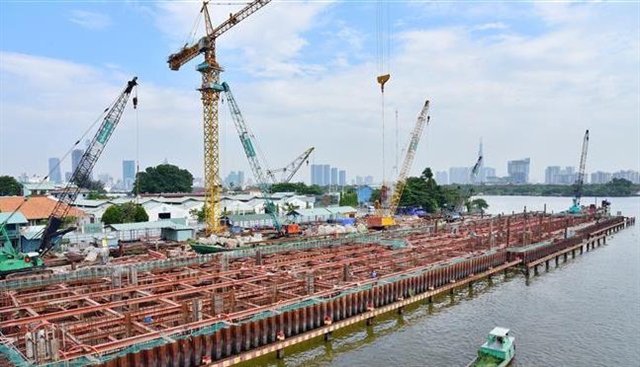 |
| Construction of the multi-trillion đồng flood-prevention project in HCM City. — VNA/VNS Photo |
HCM CITY — HCM City will spend more than VNĐ62.5 trillion (US$2.5 billion) to undertake urgent repairs of 23 disaster prevention projects in 2024.
The municipal People's Committee has approved a policy to use the city Natural Disaster Prevention Fund to support urgent repairs of disaster prevention projects this year.
The city’s Department of Agriculture and Rural Development, and the People's Committees of Tân Bình and Củ Chi districts and Thủ Đức City has been assigned the responsibility of using the funds to carry out the works.
Upon completion, the projects are expected to effectively prevent flooding caused by high tides and heavy rains, protecting a total area of about 134.5ha and 7,722 local households.
The works include repairing culverts of the flood-control dyke project along Sài Gòn River from Bình Phước Bridge to Cầu Ngang Canal; repairing 11 embankments along river and canal banks in Thủ Đức City; urgent reinforcement of landslide locations on Cầu Sa Canal bank in District 12; flood prevention on four alleys in Tân Bình District; and renovating six drainage canals in Củ Chi District.
According to the latest update from the municipal People's Committee, the city’s flood-prevention project worth multi-trillion đồng has yet to be completed.
This is the largest and most expensive flood prevention construction project ever planned for the city.
It is expected to handle tide-related floods and lessen climate change consequences in a vulnerable 570sq.km urban section inhabited by around 6.5 million people, nearly half of the city’s population.
The first phase of the project costing VNĐ10 trillion ($433.3 million) started in June 2016 and is expected to be built over the next three years.
It is 90 per cent complete, but it had been temporarily halted due to the slow disbursement of loans for the project.
About 60 per cent of the city floods at high tide and 70 per cent of the city's land is sinking. Climate change, urbanisation and higher tides on lower lands all make flooding a major challenge for the city. — VNS


